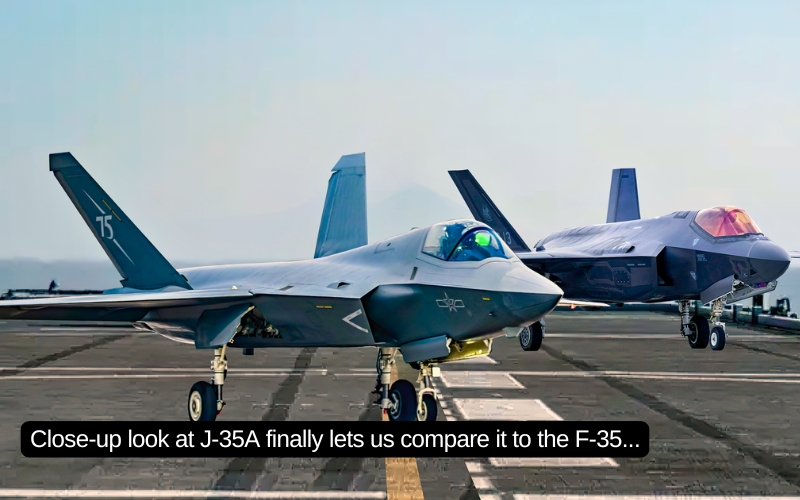Uncrewed combat aerial vehicles (UCAV) are used by militaries worldwide for various functions, including surveillance, collecting intelligence, target acquisition, reconnaissance, and the delivery of ordnance such as missiles and bombs. There is a multitude of different types of drones currently in use by various armed forces.

10 Best Military Drones In The World In 2023
Tech. Sgt. Lealan Buehrer/U.S. Air Force
BY JEFF HARPER/JUNE 27, 2023 4:10 PM EST
Uncrewed combat aerial vehicles (UCAV) are used by militaries worldwide for various functions, including surveillance, collecting intelligence, target acquisition, reconnaissance, and the delivery of ordnance such as missiles and bombs. There is a multitude of different types of drones currently in use by various armed forces.
These can be grouped into four general categories, starting with microdrones, such as the Black Hornet, measuring a mere 1-inch-by-4-inches, which British soldiers used to peek over walls in Afghanistan. Then there are small tactical drones, such as the Fulmar X, a mini-UAV used primarily for its ISTAR (Intelligence, Surveillance, Target Acquisition, and Reconnaissance) capabilities, able to fly for about 12 hours, reach speeds of 150 kilometers per hour, and with a range of 800 km.
Medium-sized reconnaissance drones are the most commonly used. These medium-range UAVs are used for ISTAR and are also known as Medium Altitude Long Endurance (MALE) or High-Altitude Long Endurance (HALE) drones. An example is the German-made LUNA (Penzberg) used in Afghanistan and Kosovo since 2000, which has a range of about 100 kilometers. Finally, there are large combat and surveillance drones, among which the largest and most expensive is the Northrop Grumman Global Hawk. The drone has sophisticated ISTAR capabilities and flies at an altitude of up to 18,000 meters, well above commercial air traffic. A single Global Hawk drone costs more than $130 million, not including the supporting ground infrastructure. Spanning all scales, here are 10 of the best military drones in the world in 2023.
MQ-9 Reaper
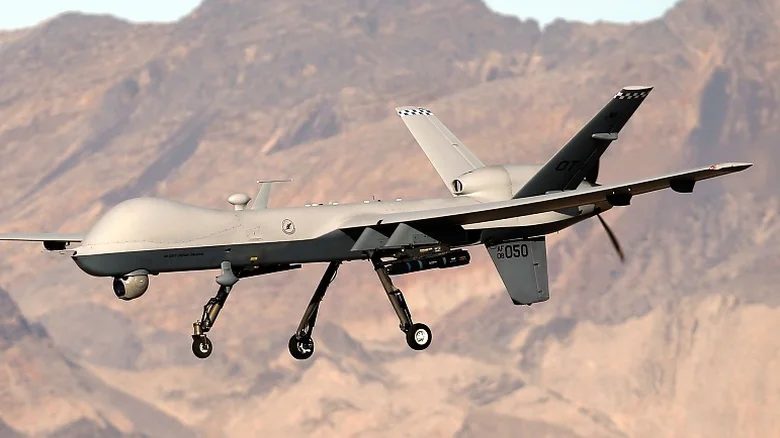
The General Atomics MQ-9 Reaper (Predator B) is an offensive strike unmanned aerial vehicle (UAV) used by the States Air Force (USAF), capable of both remotely controlled and autonomous flight operations. The Reaper uses remote split operation with a launch-and-recovery ground control station at the forward operating location and a crew based in the continental United States that executes command and control.
The MQ-9 Reaper measures 36 feet long and 12.5 feet high. It has a wingspan of 66 feet and weighs 4,900 pounds empty. The UAV is powered by a Honeywell TPE331-10GD turboprop engine producing a maximum of 900 shaft horsepower, giving it a cruise speed of about 230 mph (200 knots). The drone can carry 602 gallons of fuel and has a range of 1,150 miles. It can loiter at its flight ceiling of 50,000 feet for more than 27 hours conducting surveillance using sophisticated cameras, sensors, and radar. The Reaper can carry a payload of 3,750 pounds consisting of a variety of attack weapons.
The Air Force Special Operations Command says, “Given its significant loiter time, wide-range sensors, multi-mode communications suite, and precision weapons — it provides a unique capability to perform strike, coordination, and reconnaissance against high-value, fleeting, and time-sensitive targets.”
As of May 2021, the U.S. Air Force had over 300 MQ-9s in service. Although the decision has been made to retire the UAV, replacing it with a faster and more sophisticated model, it will remain in service until 2035.
B.A.E. Systems Taranis
Taranis is a large-scale unmanned combat aerial vehicle (UCAV) designed and built to demonstrate ISTAR capabilities including sustained surveillance, target marking, intelligence gathering, adversary deterrence, and the ability to carry out strikes in hostile territory. The UCAV is capable of pre-programmed waypoint tracking, takeoff, and landing procedures, and incorporates AI features that allow the vehicle to modify its operation to achieve an objective, based on data collected during the flight.
In July 2010, the British Ministry of Defence (MOD) unveiled the fully developed Taranis UCAV prototype, followed by high-speed taxi tests in July 2013. The first test flight was conducted in August of the same year, and in July 2014 the first in-flight footage was released to the public. Successful test flights confirm the U.K.’s objective of designing and producing a UCAV with domestic resources without relying on U.S. or European contributions. Taranis shows the U.K. has gained expertise in unmanned aircraft with stealth features and accurate long-range strike capabilities in hostile territories.
As of 2020, Taranis has been built with a 9.1-meter (30-foot) wingspan, 11.35-meter (37 feet) barrel length, and a height of 4 meters (13.12 feet). The UCAV weighs 8,000 kg (17,637 pounds) and is powered by a single Rolls Royce Adour Mk. 951 turbofan engine producing 6,500 pounds of thrust. Although Taranis is not intended to deploy weapons in combat, it is designed with two internal weapons bays and an option for installing electro-optical and radar sensors. The testing program includes simulated weapons release, typical of real-world mission scenarios.
Bayraktar Kizilema
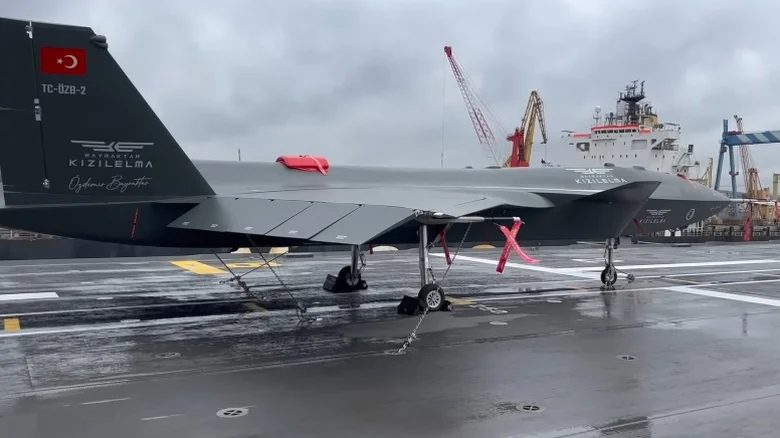
Designed and developed by Baykar in Turkey, the Bayraktar Kizilelma Fighter is an unmanned aerial vehicle (UAV) with advanced maneuvering capability and a stealthy form protecting it from radar detection. The Kizilelma has a takeoff weight of 8.5 tons including 1.5 tons of ordnance and a shape that looks like a small, manned fighter jet sans cockpit.
Powered by a Ukrainian Al-25T turbofan by Motor Sich, the drone can reach a cruise speed of 0.6 Mach up to a maximum of 0.9 Mach. It flies to an operational altitude of 30,000 feet, has a combat radius of 500 nautical miles, and can stay airborne for five hours. The drone features a low radar cross section (RCS), high situational awareness with Active Electronically Scanned Array (AESA) radar, and fully autonomous takeoff and landing. The Kizilema can conduct air-to-ground and air-to-air missions. Baykar is planning the development of two supersonic models using the Ukrainian Ivchenko-Progress AI-322 afterburning engines.
The UCAV completed its inaugural flight in December 2022, verifying its short runway takeoff and landing capability, making it ideal for deployment from an aircraft carrier. The Kizilelma is slated for duty aboard the TCG Anadolu amphibious assault ship originally expected to carry F-35B fighters acquired under the U.S. allied Joint Strike Fighter program. However, the U.S. Department of Defense excluded Turkey from the program for acquiring Russian S-400 missile systems. Both the U.S.-built Kratos XQ-58 Valkyrie drone and Russia’s Sukhoi S-70 Okhotnik are currently in development and offer similar features to the Kizilelma.
Boeing MQ25 Stingray
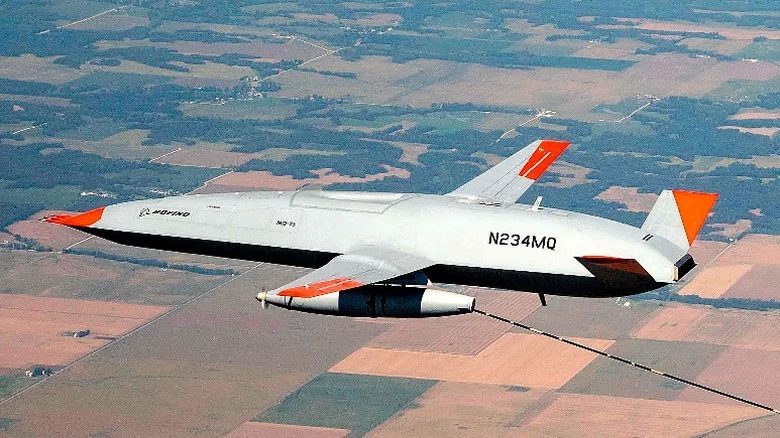
The MQ25 Stingray is a UAV system providing refueling capability to extend the combat range of jet fighters deployed from an aircraft carrier. In 2021, the drone demonstrated its functionality and capabilities when it refueled a Boeing F/A-18 Super Hornet, a Boeing EA-18G Growler, and a Lockheed Martin F-35C fighter. Operating from the USS George H.W. Bush, the MQ25 Stingray became the first unmanned aircraft in history to refuel another aircraft.
The MQ25 measures 51.0 feet long, 9.8 feet high with the wings spread, and 15.7 feet with the wings folded. It has a wingspan of 31.3 feet. The aerial refueling drone is powered by a Rolls-Royce AE3700N turbofan engine, also used in the Cessna Citation X and X+ and the Embraer Legacy 600 and Legacy 650 business jets. The MQ- UAV system is composed of two major components. The MQ-25 Air System or UAV carries the fuel while the Unmanned Carrier Aviation Mission Control System (UMCS) provides carrier integration and command and control of the MQ-25 and payload while airborne.
In addition to its primary refueling duties, the MQ-25 Stingray also provides intelligence, surveillance, and reconnaissance (ISR) capabilities. These features enhance the capability and versatility of the Naval Carrier Air Wing (CVW), an aviation organization that includes several aircraft squadrons, and the Carrier Strike Group (CSG), a formation including an aircraft carrier, at least one cruiser, a destroyer squadron, and personnel (about 7,500). The Navy will eventually enable all NIMITZ and FORD-class carriers with the MQ25 Stingray capability.
General Atomics MQ-20 Avenger
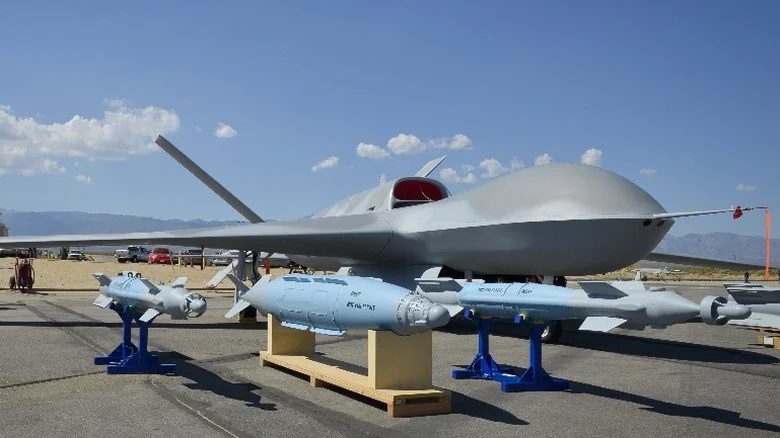
The Avenger is an advanced Remotely Piloted Aircraft (RPA) powered by a Pratt & Whitney turbofan engine producing over 5,000 pounds of thrust. The Extended Range (ER) version boasts a wingspan of 76 feet and a fuel capacity of 7,900 pounds providing over 20 hours of flight time. The Avenger can carry a total payload of 6,500 pounds consisting of a variety of weapons including Hellfire missiles. The medium-to-high-altitude RPA can reach speeds of 400 knots true airspeed (460 mph) and conduct surveillance, time-sensitive strike, and other challenging military missions.
The Avenger also features AI capabilities. On April 11, 2023, General Atomics announced that the MQ-20 Avenger had successfully completed combat maneuver exercises with both human and AI pilots. Human operators sent commands to the RPA via a satellite in low earth orbit while AI pilots, operating autonomously, tracked and maneuvered the aircraft.
The Avenger tests are part of a U.S. Air Force program to reduce the cost of building and maintaining combat aircraft. The plan includes the use of unmanned collaborative combat aircraft (CCA) capable of operating alongside piloted aircraft or autonomously for a variety of missions. While the Air Force continues to develop high-performing assets like the F-35, the B-21 stealth bomber, and the Next Generation Air Dominance program (NGAD) a sixth-generation air superiority initiative, the agency is looking for less expensive options. Air Force Secretary Frank Kendall says “The cost of each CCA could be one-quarter to half the cost of an F-35. With F-35s running about $82.5 million, CCAs could cost between $21 million and $41 million.”
EADS Baracuda
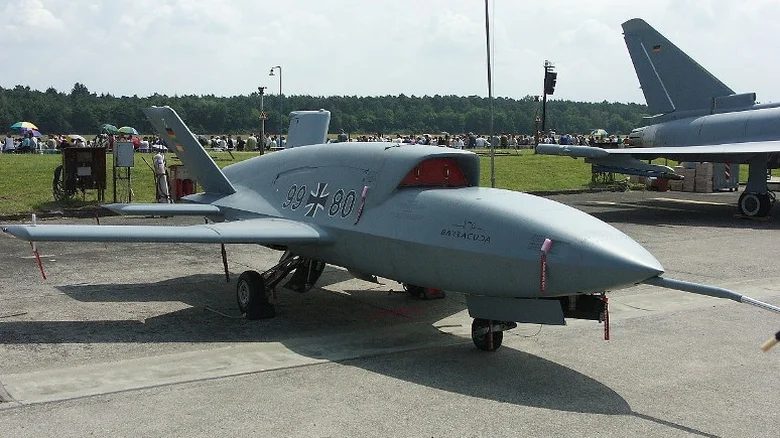
The EADS (European Aeronautic Defense and Space Company) Barracuda is a medium-altitude, long-range, fully autonomous UAV developed as a joint venture between Spain and Germany. The drone is designed and built as a demonstrator for both aerial reconnaissance and combat capabilities. The Barracuda is 8.25 meters (27 feet 1 inch) long, boasts a wingspan of 7.22 meters (23 feet 8 inches), and weighs 2,300 kilograms (5,071 pounds) empty. Powered by a single Pratt & Whitney JT15D turbofan engine producing 14 kN (3,100 pounds) of thrust, the UAV achieves a maximum speed of Mach 0.85 (647 mph). It operates up to a service ceiling of 6,100 m (20,000 ft) and has a range of 200 km (120 mi).
Although construction details are classified, available information indicates the Barracuda is built from a combination of off-the-shelf components and custom hardware systems. The fuselage is composed of the same carbon fiber composite used in the Eurofighter Typhoon (built by a consortium of four countries, the U.K., Germany, Italy, Spain, and their leading aerospace and defense companies). The Barracuda features a unique design almost entirely devoid of hydraulics (except the landing gear) operating with only electronic actuators.
Although the UAV crashed during a test flight in 2006, which grounded the aircraft for almost two years, it has since completed dozens of successful flights. The EADS Baracuda will continue as a developmental program to refine an autonomous system that can share airspace with manned military and civilian aircraft.
TAI Aksungur
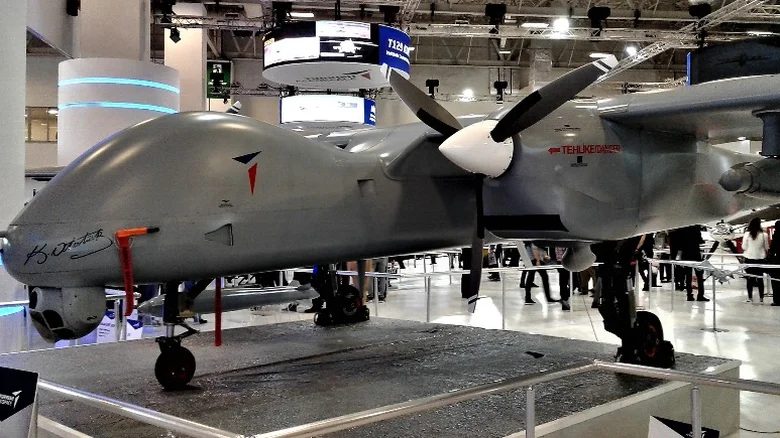
The Aksungur is a twin-engine medium-altitude long-endurance (MALE) unmanned aerial vehicle (UAV) delivered to the Turkish Navy on October 20, 2021. According to Ismail Demir, Turkey’s top procurement official, the Aksungur has a payload capacity of 750 kg and a maximum flight time of 50 hours.
The Aksungur is a Medium Altitude Long Endurance (MALE) class UAV System measuring 11.6 meters long with a wingspan of 24 meters. Powered by two PD-170 dual turbo diesel engines producing 170 horsepower each, the drone can carry a payload of 750 kg for 12 hours at an altitude of 25,000 feet. The UAV has a maximum takeoff weight of 3300 kg and can reach its service ceiling of 40,000 feet. The Aksungur provides 3 hardpoints on each wing with 500 kg, 300 kg, and 150 kg capacities. It features Teber 81 and 82 guidance kits for laser-guided Mk 81 and 82 bombs.
TAI designed the Aksungur using experience the drone manufacturer gained in combat with a previous model, the ANKA UAV. The Aksungur is equipped for ISR (Intelligence, Surveillance, and Reconnaissance) missions conducted either during daytime hours or at night. Drone sorties include electro-optical (EO) and infrared (IR), Synthetic Aperture Radar (SAR), and Signal Intelligence (SIGINT) payloads.
The UCAV can also be loaded with several types of air-to-ground weapons. During pre-delivery testing, TAI loaded 12 MAM-L smart munitions onto the drone while it remained airborne for 28 hours at an altitude of 20 thousand feet. The MAM-L is an armor-piercing high explosive blast fragmentation, thermobaric weapon. The state-controlled missile manufacturer, Roketsan, says the Aksungur “offers high strike precision and efficiency with alternative warheads against fixed and mobile targets.”
Israel Aerospace Industries Heron

The Heron advanced UAV system built by Israel Aerospace Industries performs surveillance and target acquisition over large areas, providing real-time information on enemy battlefields. The Heron reaches a maximum height of 32,800 feet and is capable of fully automated take-off and landing, even under adverse weather conditions.
The Heron (Machatz 1) MALE unmanned air vehicle system measures 8.50 meters long with a wingspan of 16.60 meters, weighs 280kg empty, has a maximum take-off weight of 1,150kg, and a maximum payload of 250kg. The UAV can remain airborne for up to 45 hours and has a range of 350 kilometers. The Heron is powered by an Austrian-made turbo-charged, four-stroke, four-cylinder, horizontally opposed Rotax 914 aircraft engine producing 115 horsepower. The drone reaches a maximum speed of 130 mph and climbs at a rate of 492 feet per minute.
The Heron UAV has been produced in several variants. EADS developed the Eagle variant for the French Airforce. It flies at a height of 30,000 feet for 40 hours and carries a 250kg payload. The Heron TP variant flies at 45,000 feet for about 36 hours. According to Airforce Technology, it “can carry multiple payloads and perform multiple missions such as COMINT, SIGINT and IMINT (image intelligence) or SAR and communications relay.” The Heron MK II variant can reach an altitude of 35,000 feet and travel at a speed of 161 mph. Equipped with a Rotax 915 iS engine, the UAV is built with a wide robust body for carrying additional payloads.
MQ-28 Ghost Bat
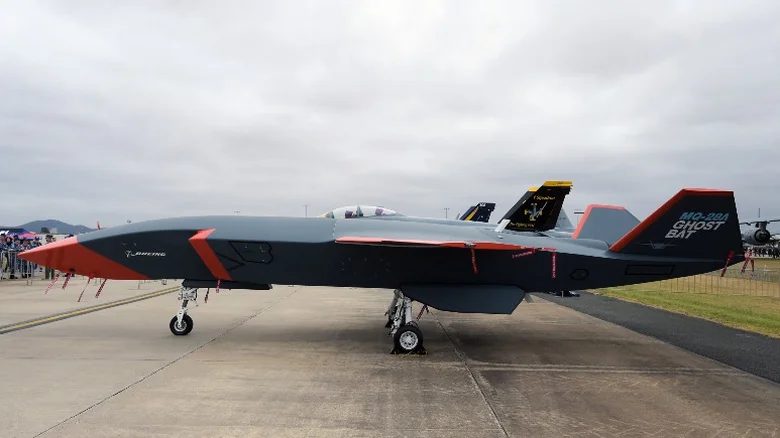
Developed by Boeing Australia, the MQ-28 Ghost Bat is a UCAV incorporating artificial intelligence (AI) and the capability of communicating with sixth-generation fighters and bombers. Boeing claims the Boeing MQ-28 has the potential to “provide a disruptive advantage for allied forces’ crewed and uncrewed missions.” The Ghost Bat, measuring 38 feet (11.7m) long with a range of more than 2,000 nautical miles, is equipped with integrated sensor packages onboard to support ISTAR, tactical early warning missions, and more. Furthermore, the UCAV uses AI to fly independently on autonomous missions or to support adjacent crewed aircraft while maintaining a safe distance.
The U.S. Air Force announced in October 2022 the beginning of flight experiments with the MQ-28 combat drone designed to learn how to operate unmanned aircraft alongside fighter jets. The Ghost Bat may be a good fit for the Air Force’s Collaborative Combat Aircraft program which seeks to learn how semi-autonomous combat drones could interface with the service’s fifth and sixth-generation fighters on combat missions. The Ghost Bat is a potential test vehicle to verify the integration of combat drones in the daily operations of a fighter wing.
In addition to the Boeing MQ-28 Ghost Bat, two other UCAVs could be candidates for the Air Force’s program: the XQ-58 Valkyrie from Kratos Defense and the MQ-20 Avenger from General Atomics. Air Force Secretary Frank Kendall indicated a CCA competition could begin as early as fiscal 2024. He said, “You’d be integrating these [drones] with existing aircraft in a way which sort of prove out some of the tactics, techniques, and procedures, as well as things like maintenance concepts and organizational structures.”
XQ-58 Valkyrie

The XQ-58 Valkyrie, like the MQ-28 Ghost Bat, is designed to perform duties as a loyal wingman, flying alongside manned fighter jets in combat. Intensive testing conducted since 2019 has shown the XQ-58 is capable of following basic commands and autonomous determination of the best flightpath and throttle settings.
Power is provided by a turbofan engine producing a maximum thrust of approximately 2,000 pounds, capable of pushing the XQ-58 Valkyrie to a cruise speed of Mach 0.72. The UAV has a maximum range of 5,556km and can operate at altitudes from 50 to 45,000 feet. The XQ-58A features a stealthy design with a trapezoidal-shaped fuselage supporting swept-back wings and a V-shaped tail that discourages detection and tracking. The UAV measures 9.14 meters long and has a wingspan of 8.2 meters.
The aircraft is constructed with commercial-off-the-shelf (COTS) components, and has a dry weight of 1,134kg, while its maximum take-off weight (MTOW) is 2,722kg. The XQ-58A Valkyrie’s open mission system architecture integrates with customer-specific payloads up to a maximum of 544kg. An internal weapons bay holds at least two GBU-39 small-diameter bombs, and lethal weapons can be carried on its wing stations.
In November 2022, two XQ-58 Valkyrie were shipped to the U.S. Air Force 40th Flight Test Squadron stationed at Eglin Air Force Base, Florida. Tests will confirm the drone’s manual and pre-programmed flight control system capabilities and help the USAF develop the infrastructure required for operating a UAV. The USAF expects to conduct crewed-uncrewed teaming with the Valkyrie performing combat missions alongside traditional fighter jets such as the F-35 by fall 2023.









